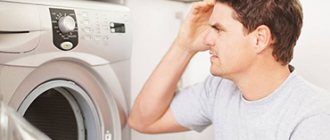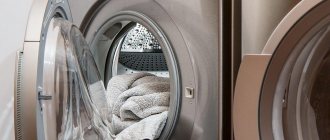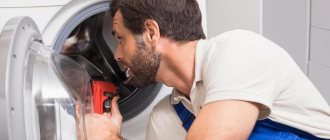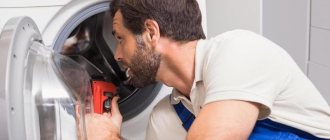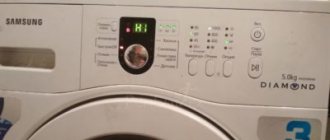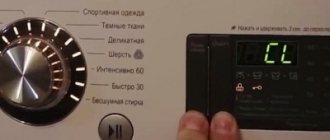- Shock absorbers or dampers
Washing clothes nowadays is not difficult. All the once manual work has been taken over by equipment that washes, rinses and spins clothes, and all this quickly and almost silently. Nevertheless, many users are familiar with the situation when the washing machine vibrates strongly during the spin cycle.
Strong vibration may be a sign of a serious problem with your washing machine.
This fact causes irritation among household members, but we should also not forget that in some cases it indicates the presence of serious malfunctions in the device. Sometimes user inaction can lead to serious damage to expensive equipment beyond repair. In this article, we will help you figure out why the washing machine jumps during the spin cycle, and we will tell you how to eliminate this inconvenience.
How to connect the washing machine correctly
To ensure trouble-free operation of the washing machine, it is necessary to install it correctly, choosing the optimal location. Before first use, be sure to read the instructions in order to operate the device safely. The rules for connecting equipment consist of the following steps:
- choosing a place where the washing machine will be located;
- preparation for operation;
- connection to water supply;
- sewer connection;
- connection to the electrical network;
- installation of equipment.
First of all, you need to choose a location for the device. If the bathroom is small, then the machine can be placed in the kitchen or bathroom. The main thing is that the floor in this place is level, so that it is possible to connect sewer and water pipes, as well as connect the device to electricity. As for the bathroom, excessive humidity can negatively affect the parts, thereby shortening the service life of the equipment. Using the machine in the bathroom is not very convenient, considering that washing can last for hours. If the washing machine is placed in the kitchen, the beautiful appearance of the shiny front panel may be ruined by splashes and stains.
The device preparation stage includes the removal of packaging materials and other shipping parts, such as staples and bars
Important: Do not turn on the washing machine before you have removed the transport bolts, as this may cause it to malfunction. If the kit contains plastic plugs, they should be installed in place of the bolts
It is important to understand that connecting equipment to the water supply is a responsible matter, since improper implementation of this item can lead to water leakage. Usually a water hose and the necessary fittings are supplied, but its length may not be sufficient to connect to the pipe in the required place
There are two ways to solve this problem: purchase a longer hose or connect the pipe directly to the machine. If you decide to go the first route, then when buying a part, you should take the length with a margin so that the tube does not get stretched, much less twist, stopping the water supply.
Connecting a washing machine to the sewer is possible in two ways: fixing the pipe to the drain of the bathtub or washbasin, or connecting the pipe to the sewer pipe. The first option does not provide reliability, since the hose may be accidentally touched and water will spill onto the floor. It is optimal to connect the device permanently, in which case the reliability of the connections will be guaranteed. When connecting household appliances at this stage, it is necessary to take into account the length of the drain hose and the presence of a special siphon, which will prevent sewage and unpleasant odors from entering the device.
When connecting the device to the mains, please note that the machine consumes quite a lot of energy. Therefore, this procedure must be carried out carefully, taking into account the fact that the machine is in contact with water and current. To ensure safe operation, it is recommended not to use extension cords, but to supply electricity using special plastic boxes. The use of sockets with the appropriate degree of electrical safety is considered the best option.
After you have connected all the required hoses and removed the shipping bolts, you need to level the washing machine using the adjustable feet. It is recommended to place the device on a concrete surface to ensure a stable position. Do not place various objects under the legs in an attempt to level the equipment.
Remember that vibration during the spin cycle may indicate serious problems with the device.
I did and checked everything, but the machine still jumps
Previously, cars were much more stable. For example, my mother has a SAMSUNG machine that is 15-20 years old. So it stands like a glove, doesn’t jump anywhere and doesn’t walk around the kitchen (they only replaced the shock absorbers after 12 years and that’s it).
And my new LG just jumps around like a goat, although it seems like I did everything as it should: the level, the floor, and removed all the bolts, but still, it walks on the tiles, just catch it! Why and what to do?
Everything is simple here. Previously, the machines were wide, for example, my mother’s was about 60 centimeters long, the drum was made narrow but long, and even had a belt drive (the belt works as an additional damper). Such machines have correctly distributed weight. So they stand like a glove.
My new one is much narrower, only 40 centimeters, it has a wide but short drum, and direct drive. Accordingly, the weight distribution of the laundry is much worse. In simple words, the radius of the drum is larger, and if there is not much laundry and it is crumpled in one corner, then a strong imbalance results. And since the body is narrow, it cannot cope with this imbalance! So your car jumps, even a new one straight from the store. The question arises - what to do?
Why does the washing machine jump during the spin cycle?
So-called washing machine jumping is a strong vibration that causes the equipment to twitch and move from its place. This phenomenon causes a lot of problems, at least it is accompanied by loud noise, which disturbs not only residents, but also their neighbors. There are several possible reasons for this behavior of the equipment.
Unsuitable installation location
The wrong location for the washing machine is one of the most common causes of jumping. Taking into account the force of vibration that occurs during spinning, the technique is often called capricious - it requires a flat and hard floor. There are two possible options:
- unstable floor covering, soft floor (for example, wooden) - in this case, the very place on which the machine is installed will be mobile, which means that with strong vibration it will bounce significantly;
- uneven floor. Even if there are tiles at the installation site, this does not guarantee a stable position of the equipment. Inexpensive tiles themselves may be a little crooked, and flaws during installation are possible. Thus, different floor levels under the legs of the washing machine will increase vibrations and provoke jumps.
There is only one method to solve the problem - eliminate floor defects. So, if it is soft or shaky, it is better to move the equipment to another place, and if the floor is crooked, then it will be enough to adjust the height of the legs of the machine. It's easy to do:
- First you need to determine which legs are adjustable. To do this, just swing it - the leg on which the machine falls when swinging needs to be lengthened.
- Use a wrench to turn the adjustable leg counterclockwise. Sometimes this can be done without lifting the car, but if this is inconvenient, then the equipment will still have to be tilted.
- When the rocking goes away, you need to check whether the machine is level - for this you should use a building level.
Improper preparation for use
If jumping appears on a machine that was recently purchased, the first thing you need to check is the transportation bolts. They are fasteners that hold the drum during transportation and must be removed before starting the device - then the drum will fall into place and the vibration damping system will work at full strength. Often, temporary fastenings are simply forgotten, and then the device begins to vibrate and jump violently. In this case, it is urgent to remove the forgotten bolts - their number depends on the specific model and manufacturer; you can do this yourself, following the instructions for commissioning.
Before using the machine, be sure to remove the transport bolts
Machine breakdown
If a breakdown occurs in the vibration damping system of the washing machine, it begins to behave extremely actively and bounce strongly during the spin cycle. If the device is installed correctly, then one of the parts may have failed:
- shock absorbers, which are located below on the sides of the tank and absorb vibrations through the resistance of the piston;
- springs on which the tank is attached to the top (they stretch over time);
- counterweight (a large weighting material that is located on top of the tank and ensures the stability of the washing machine; over time, it can crumble or become loose on the fasteners).
There is only one solution to this problem - call a competent washing machine repairman, who will carry out diagnostics and make the necessary replacement of parts.
Incorrect download
Strong vibration and jumping with a characteristic roar of the drum often occur due to non-compliance with the operating rules of the washing machine. Things in the drum, huddled together in one big lump, simply do not allow it to rotate evenly, creating vibrations that are dangerous for the safety of the equipment. To avoid this problem, you need to take into account a number of rules:
- do not exceed the weight of loaded items specified in the instructions for a specific model of washing machine;
- things need to be laid out when loading into the drum; they cannot be thrown in one lump;
- The problem often occurs when washing one large item - in this case, you need to stop the cycle and redistribute the item in the drum.
Strong vibration and, as a result, jumping during operation of the washing machine is a common problem that can be caused by both improper operation and serious breakdowns. If eliminating simple violations does not produce results, then you should contact a specialist.
Failure to comply with operating rules
The most common reason. The round shape of the drum helps to mix wet laundry into one pile. Manufacturers write in all instructions about the need to put small and medium-sized items into the machine along with large and bulky items to create balance. But it’s enough to leave one duvet cover unfastened for them all to become one big heap, which is difficult to turn around. To prevent such situations, you need to put the laundry folded for washing, making sure to fasten all the zippers and buttons.
Overload can also cause the washer to bounce and jump. In this case, stop the machine, drain the water and separate the laundry into parts. Always load laundry evenly, since the service life of the equipment depends on proper use.
Troubleshooting
The first thing to do if the washing machine jumps during the spin cycle is to check that the installation is correct. The unit must stand on a flat, hard surface, preferably on a monolithic floor. If you place the device on a wooden surface, then vibrations and noise during spinning cannot be avoided.
You also need to check the adjustment of the legs, which can unwind during operation of the machine, which in turn will cause the equipment to lose stability. To avoid such a problem in the future, it is necessary to secure each support with a lock nut.
When installing a new washing machine, users quite often make the following mistake: they forget to remove the transport bolts. They are located on the rear panel and serve to secure the tank when transporting equipment. If they are not dismantled, the machine will vibrate and make a lot of noise when washing, and will soon fail altogether. You can unscrew the fasteners using a wrench.
Be sure to remove the shipping bolts before use.
Once the installation issue has been resolved, it is important to check the laundry load volume. If the clothes in the drum are unevenly distributed, clumped or there is too much of it, this can lead to increased shaking of the washing machine
In this case, stop the machine during the spin phase, distribute the clothes manually or remove a few extra items, and then resume operation of the unit.
If you are still wondering why the washing machine jumps during the spin cycle, remove the top cover of the housing and inspect the special springs that hold the tank on top. They quickly wear out and lose their elasticity, which affects the operation of the unit. Within a few months after purchasing the equipment, the springs may fail. If you have the necessary spare parts, it is easy to replace parts at home.
To get to the springs, just remove the top cover of the washing machine
In machines from Indesit, Bosch, Samsung and models of other brands, shock absorbers designed to dampen tank vibration often fail. You can access them through the rear or front panel of the device (depending on the model). The shock absorbers are attached with bolts or plastic clips: one side to the tank, the other to the bottom of the body. When they wear out, they weaken, causing the washing machine to vibrate strongly during the spin cycle. To replace parts, you need to disconnect the fastenings of the old shock absorbers and install new ones, securely fixing them in place. Replacement is not difficult if you have at least minimal knowledge about the structure of the washing machine.
Proper shock absorbers hold the tank and reduce vibration levels
Often, the washing machine rattles and jumps due to the destruction of counterweights - plastic or concrete blocks that are bolted to the tank and balance it. Over time, fastenings can become loose, resulting in increased vibration and noise. The material used to make the counterweights also matters. For example, an LG machine has concrete parts that often crack or crumble. Plastic blocks are considered more durable and reliable. Despite this, they also need regular inspection, especially if the machine constantly rattles during the spin cycle. Timely checking of counterweights for destruction or loosening of fasteners will help to avoid strong vibration and prevent damage to other parts.
Over long periods of use, the mountings of the counterweights weaken.
When answering the question why the washing machine shakes during the spin cycle, one cannot help but talk about the bearings. These parts wear out over time and become a source of noise, namely squeaking or grinding as the drum rotates. If the problem is left unattended, the bearings will completely collapse, which will lead to free movement of the drum shaft on which they are installed. At the first symptoms of a malfunction, it is worth replacing the supporting part, otherwise the cost of repairs may increase significantly. It is difficult to replace bearings at home, so entrust the work to a specialist.
Only a professional can replace worn bearings
When the washing machine jumps and knocks, it creates discomfort for others and can end badly for the equipment.
In order not to cause the unit to suffer serious damage, it is important to identify the cause of the malfunction at the first symptoms and eliminate it as soon as possible. We hope our recommendations will be useful for those who are looking for ways to cope with the constant rumble and vibration of the device
Which models vibrate most often?
Despite new developments in the design of automatic machines, manufacturers are unable to achieve complete noise reduction. Rapid rotation of the drum, natural vibration is most pronounced in:
- built-in narrow models of the brands LG, Indesit. The narrow body and reduced support lead to movements due to poor fastening or improper installation;
- cars with metal tanks. The noise is due to poor sound insulation;
- small-sized equipment.
Compared to full-size models, manufacturers use fewer engine-silencing devices. Narrow built-in model Metal tank Difference between standard and small model
Important! The optimal noise level during washing is 50 dB, during spinning - 70 dB. The indicator is written in the device passport.
Rules for loading laundry
To prevent noise and jumping of the washing machine, you need to put the optimal number of things in the drum. The capacity of the model, for example, 6 kg, indicates that you can load up to 6 kg. Before the program starts, the laundry is straightened and evenly laid out on the drum.
Be sure to pay attention to the maximum load
If there is a lack of weight, the automatic machine spins without being weighed down. Free movement of the drum leads to loosening. If you regularly wash one item, the device may break.
Troubleshooting yourself
To eliminate some malfunctions, it is not necessary to take the device to a service center; you can do everything yourself. To do this, you need to do the following:
- If foreign objects get behind the drum, you need to bend the rubber seal of the hatch on the front panel, fixing the drum. After this, you should hook the item and pull it out. If you can’t do this, the only thing that will help is removing the heating element and disassembling the automatic machine, which is best left to a professional.
- If the laundry is unevenly distributed, you need to perform an emergency drain of water and unlock the hatch. Next, you should take out the laundry, separate them from each other and carefully place them in the drum. If overload is observed, then remove some of the things from the machine.
- If there is a problem with installation, you need to determine the correct height using a level and adjust the legs of the washer. You can also level the floor or lay down a sheet of chipboard, fiberboard, or anti-vibration pads. Using a rubberized mat will also help if the device slides on the surface.
- If there are transport bolts, you need to turn the machine with the back wall towards you and unscrew 3 or 4 fasteners with a wrench or pliers. In some cases, there are more fasteners, and they are located under the top cover, so it is better to check the instructions first. In their place are installed the plastic plugs supplied. The removed bolts should not be thrown away; they will be useful when moving or rearranging during repairs.
- If you have problems with the shock absorbers, you need to unscrew them and try to compress them. Since their task is to dampen vibrations, movement should be difficult. If this is easy to do, it means that both structures need to be replaced. If only one is corrected, the stiffness will be different and the load will be distributed unevenly.
- If there are difficulties with the counterweights, you need to remove the machine panel (using pliers, a screwdriver, a wrench) and inspect the counterweights. If they crumble, then buy and install new ones. If it is not available for sale, you can tighten the parts with metal plates or glue them together, although this is a rather complicated option. When the counterweights look intact, it is worth examining their mountings, as well as the springs. If they break, they are replaced, but if they are intact, the bolts are tightened.
- To resolve the issue with the electric motor, you need to remove the back panel and try to tighten the fasteners. Also, removing the far cover will allow you to determine the condition of the belt leading from the engine to the drum. Other actions with the motor and the programmable part of the device cannot be carried out independently.
- Bearing failure can only be repaired by a service center.
Identifying the problem
To determine why the washer jumps during the spin cycle, you must first listen to the sounds it makes:
- if the problem lies in the bearings, then a characteristic grinding noise is heard during movement;
- in the event of a breakdown of the shock absorbers, springs or counterweight, a knock is heard, indicating that the drum is hitting the body;
- when the equipment is not positioned correctly, the laundry is unevenly distributed, or the transport bolts are not removed, the washing machine makes a rumble, but there is no knocking or grinding.
You can try shaking the washing machine. When installed correctly, it should not slide or wobble. You can detect fallen fragments by shining a flashlight through the drum grille. The transport bolts are also easy to find: they are located on the rear wall of the machine.
To determine problems with shock absorbers, you need to put the car on its side and look at it from below. Finding difficulties with counterweights, springs and their fastening requires removing the top and front panels of the device.
How to secure a washing machine if it bounces
Having dealt with the reasons that cause an automatic car to vibrate and bounce excessively, let’s move on directly to eliminating them.
We eliminate the reasons ourselves
Often the problem of increased vibration occurs when the device is installed incorrectly or is overloaded with a large number of things. Such problems can be resolved without outside help. This will be discussed further.
Correct installation of equipment
The proper operation of the equipment depends on how correctly it is installed. How to set up a washing machine so it doesn't jump? Read the recommendations below.
- If your washing machine bounces when spinning or washing, check whether the shipping bolts are removed. They must be removed after installation. Otherwise, you cannot avoid machine jumps, and wear of its important components is guaranteed.
- The placement of the automatic machine is an important point that needs to be taken seriously. The equipment must be level, without any distortions. For this purpose, special legs are provided that just need to be adjusted correctly.
- The surface on which the washing machine is installed should not be slippery. If jumps and movement occur, use additional anti-vibration stands.
Correct operation
If you have leveled the machine as expected, but the problem remains, you need to look for another reason. The drum may have been overloaded or an imbalance may have occurred during the washing process.
To prevent such a situation, it is important to adhere to certain rules:
- follow the maximum permissible weight of laundry when loading, which is provided for the automatic machine;
- do not exceed the drum loading volume - if the drum is 2/3 full, this is already an excess;
- Do not allow the laundry to bunch up in a ball. Therefore, before loading it into the washing machine, it should be straightened and spread evenly over the drum (you can use special laundry bags).
Small objects getting into the gap between the tank and the drum is a common phenomenon. To remove a foreign object, follow the recommendations below.
- Arm yourself with a flashlight and illuminate the tank from all sides.
- If you find a foreign object, try to pull it out with a hook-shaped wire at the end.
- If the attempt is unsuccessful, you will have to partially disassemble the machine.
Operate the washing machine according to the rules set out in the instructions and install taking into account all recommendations. This will save it from premature breakdowns, and you from unnecessary hassle in finding the cause of the malfunction.
When you can’t do without calling a specialist
In case of serious technical breakdowns, it is better to call a repairman. But if you have certain skills and are confident in your abilities, you can try to fix the breakdown yourself. The malfunction should be corrected immediately so that it does not lead to more serious consequences.
Damage to shock absorbers or springs
Shock absorbers and springs are elements of the device that prevent excessive vibrations when spinning at high speeds. Strong vibrations and characteristic knocks may indicate a malfunction of the shock-absorbing system. In other words, the shock-absorbing elements are simply worn out and require replacement.
If one shock absorber has become unusable, replace both at once. You definitely won’t save money, since over time you’ll still have to change another one. Do the same with springs that have worn out and lost their elasticity.
Problems with attaching counterweights
A counterweight is a concrete or plastic weight that is placed at the top and bottom of the hull, and sometimes on the sides. Its task is to “block” excessive vibrations of the automatic machine. There are two types of problems with the counterweight:
- deformation of the counterweight itself. In this case, you need to replace the worn part with a new one;
- problems with fastenings. Here they will need to be adjusted or replaced.
Bearing wear
Often the cause of noise and vibration is faulty bearings. Over time, when exposed to moisture, they begin to rust and deteriorate.
The defective part should be replaced immediately. Entrust this procedure to a service center specialist.
Use household appliances correctly, follow the manufacturer’s recommendations, then you definitely won’t have to look for the cause of the breakdown.
Badly
Interesting 2
Super 1
Nuances of troubleshooting
If the washing machine often jumps during a quick spin cycle, then experts will tell you what to do with it. Independently allowed:
- Remove transportation fasteners based on the manufacturer's instructions;
- Adjust the legs in height and install equipment according to the level;
- Install anti-vibration devices - mats and stands;
- Determine bearing failures by turning or rocking the drum;
- Repair the upper, front or rear counterweight by removing the upper housing;
- Tighten the fastenings of parts if they become loose.
Important! If you are not confident in your abilities and knowledge, entrust the repair to specialists.
Incorrect installation and operation of the device
The reasons why the machine rattles and jumps during the spin process are very diverse - from improper installation of the unit to failure of its important components. And while some of the causes can be eliminated on your own, eliminating others will require the help of a qualified specialist. To begin with, we suggest you figure out in which cases you can cope with the problem without outside help.
Shipping bolts not removed
If the problem was discovered immediately after delivery of the new equipment, it may not be a problem with the device at all. Often, during installation of the unit, buyers forget to unscrew the shipping bolts located on its rear panel. Such bolts firmly fix the washing machine tank to protect the device from damage during transportation.
When installing a new washing machine, be sure to unscrew the shipping bolts
After removing the parts, the drum hangs freely on springs, which dampen vibrations of the device during washing. If the bolts are not removed, the rigidly mounted drum will vibrate violently, causing rapid wear of many internal components. The number of shipping bolts may vary between different models of equipment, so we advise you to check the instructions before removing them. In order to remove the parts, you will need a wrench of the appropriate size. For washing machines from Indesit or Zanussi, its size is 10 mm, for devices from Samsung, LG or Bosch brands - 12 mm.
The device is unstable on the base
Another reason for the strong vibration of the washing machine during the spin cycle may be its incorrect installation.
First of all, pay attention to the surface on which the device stands: it should be hard and monolithic (ideally, a concrete floor or tile). Most often, machines bounce on a wooden floor: at high speeds, it bends under the weight of the device, increasing the vibrations created by the drum
In rare cases, the machine may jump because the floor in the room is too smooth and slippery. In this case, you can cope with the rumble by placing a rubber mat under the device or by sticking special anti-slip stickers on its legs. If you can't find similar stickers in the store, use double-sided construction tape.
You can restore the washing machine's stability by adjusting the height of its legs.
We also advise you to pay attention to how tightly the legs of the device are screwed. Sometimes during operation their fastenings become loose, which leads to instability of the machine.
To check that the legs are secure, simply rock the machine with your hands. If it is “limping”, then the supports should be adjusted and secured in the correct position with a lock nut. You can also reduce the length of the legs by screwing them deeper into the base of the device. This way you will achieve greater resistance of the unit to vibrations.
The laundry is unevenly distributed in the drum
To avoid many problems during operation of the device, the developers advise you to always follow the recommendations for the weight of the loaded laundry. Uneven distribution of items can overload the drum and cause the machine to rattle during the spin cycle. If you suspect that the rattling noise is caused by an imbalance, follow these instructions: stop the spin cycle, remove some clothes from the machine, spread the remaining laundry evenly around the drum, and then restart the spin program.
Do not overload the washing machine with laundry
Transport bolts
If you install the washing machine yourself and have never had to do this before, then you can leave the so-called transportation bolts. Which are required to be installed at the factory so that the tank itself with counterweights does not move during transportation.
If you don’t remove them, the machine will wash them! But its balancing is disrupted (since these bolts often hold counterweights) and when spinning, a rumble occurs.
The easiest reason is to simply remove (unscrew) these bolts, usually there are four, rarely six on the back. Performance should be restored
Wear of springs and shock absorbers (dampers)
The longer the life of the washing machine, the less elasticity of the springs fixing the tank becomes, and their ability to control vibrations is lost. To fix the problem associated with worn springs, you need to replace them all with new ones.
Another reason why washing equipment bounces a lot is faulty shock absorbers. They, like springs, muffle the swaying of the drum during intense rotation. Their failure results in tank subsidence. You can check the condition of the shock absorbers yourself: open the machine door and slightly pull the tank towards you, and then release it. If it starts to move to the sides and does not fit neatly into place, then the shock absorbers will need to be replaced with new ones. In addition to shaking, spinning can be accompanied by tapping - these are faulty elements hitting the body.
Problems with dampers usually result in the breaking of the plastic covers that surround the tubes or plates extending from the tank. The process of replacing broken covers also requires experience and skill. In addition, there is a problem with selecting a suitable lining; it is more advisable to replace the dampers with new ones.
Damage to the internal elements of the machine
If none of the above manipulations eliminated the excessive vibrations, then there is a malfunction somewhere in the device. To eliminate it, in most cases you will need the help of a specialist. The failure of one or more parts of the device may be the reason why the washing machine shakes during the spin cycle. What specific details do you need to pay attention to to solve such a problem?
Shock absorbers or dampers
Shock absorbers are installed in machines in order to dampen excessive vibrations created by the drum at high speeds. During operation, they gradually weaken and fail. Checking the condition of the shock absorbers is usually not difficult: just open the washing machine door, pull the tub towards you a little, and then release it. If it stays in place, there are no problems with the springs. If it starts to sway in different directions, you will need to replace the faulty shock absorbers. As a rule, there are two of them in the device; they are secured with bolts or plastic bushings with latches. One end of the element fits to the bottom of the body, and the other to the washing machine tank. In order to dismantle the parts, you need to unscrew the nuts and remove the bolts or plastic bushings, and then insert new shock absorbers and secure them in the device.
Worn shock absorbers can also cause severe vibration of the unit.
Counterweights
Counterweights are heavy blocks inside the body of the machine, made of concrete or plastic and attached to the tank of the device with bolts. Over time, they can crack or crumble (such phenomena are especially common in cars with concrete counterweights). Also, due to excessive loading of laundry into the drum and the vibrations created, the fastening bolts on the parts may become loose. As a result of malfunctions, instead of dampening vibrations, the counterweights begin to amplify them, which is why the washing machine jumps during the spin cycle. Normally there are two counterweights. You should carefully inspect their integrity and, in case of malfunction, replace them with new ones. It is also worth inspecting the fastenings, tightening them or replacing them with others.
If vibrations occur, it is necessary to check the integrity of the counterweights and inspect their fastenings
Bearing
A characteristic iron grinding sound during the washing process may indicate wear and destruction of the bearings in the washing machine. Normally, they prevent free lateral movement of the shaft with the drum. If you suspect that the noise of the device is caused by bearing faults, we advise you to immediately call a technician to repair the equipment. You are unlikely to be able to repair or replace parts yourself, but if they fly apart during operation, they can damage important components of the unit with fragments.
Wear of the bearing assembly may cause increased vibration during spinning.
Springs
Just like shock absorbers, the springs in the machine (the tank is attached to them) dampen the vibrations of the drum during operation. They, like other parts, are subject to wear during use. To eliminate problems associated with worn springs, they will need to be completely replaced.
We really hope that this article helped you understand the question of what to do if your automatic washing machine rattles when washing. Remember that a jumping machine can not only cause damage to surrounding furniture, but also damage its internal parts: strong vibrations lead to the fact that all components of the unit experience increased load, which can cause more serious damage.
What causes the shaking?
Normally, the machine should vibrate, but almost silently, and a noticeable increase is only permissible during the spin cycle. If the vibration develops into unhealthy and suspicious shaking, then there are good reasons for this. Some of them are harmless and can be easily fixed, while others indicate large-scale breakdowns and require costly repairs. To understand the tactics of action, we study the entire list:
- unstable position of the machine;
- the resulting imbalance;
- exceeding the maximum weight when loading things or, on the contrary, insufficient amount of laundry in the drum;
- transport bolts not removed;
- foreign objects getting inside the machine (keys, hairpins, pins, small toys, children's socks);
- faulty shock absorption system;
- worn bearing assembly;
- problems with counterweights (loose fixation or damage to the concrete block);
- broken electric motor.
Many causes can be identified and corrected on your own if you know the structure of the washing machine and remember safety precautions. The main thing is not to let the shaking take its course, but to immediately begin to act. Specific steps and recommendations are provided below.
Unbalanced laundry in the drum
Another common occurrence is when small items, during the washing and spinning process, form a lump inside a larger item, for example, in a pillowcase or duvet cover. As a result, a heavy lump is formed, the mass shifts during movement - during spinning, the machine jumps in the direction of displacement and rotation of the drum. In this case, an error may be projected on the display in the form of the letter values UE or UB. This is a direct sign that the drum is spinning with interference.
The solution is simple: emergency drainage, redistribution of things inside the machine after unlocking the door. Then just start the spin cycle.
Advice! Wash small items and underwear in special bags. This will prevent imbalance and preserve delicate fabrics.
Calling a master: how to find and how much to pay?
If you can’t handle the breakdown yourself, you need to contact a company that repairs Samsung household appliances. You can find such a company on the Internet.
The cost of work depends on the company's pricing policy, and does not include the price of parts that require replacement.
In the capital, the average price for services is:
- replacement of shock absorbers or bearings – from 1,200 rubles;
- replacement of brushes – from 900 rubles;
- removal of a foreign object – from 1,200 rubles, etc.
If the machine is under warranty, you should not disassemble it yourself, as this will void the warranty. You can find out about companies that support such machines when purchasing equipment in a store.
Regardless of the severity of the breakdown, it is better to trust the work to a representative of a company repairing household appliances, and not to a private individual based on a random advertisement. This will give confidence in the quality of the repair performed and prevent fraud. In addition, companies provide a guarantee on their work.
Find out more information about repairing Samsung washing machines in this section.


